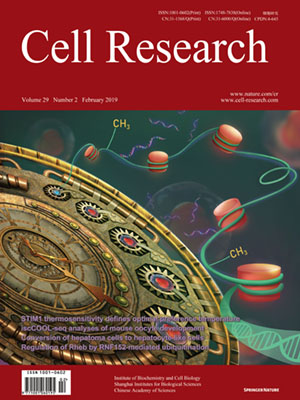
Advanced Search
Submit Manuscript
Advanced Search
Submit Manuscript
Volume 29, No 2, Feb 2019
ISSN: 1001-0602
EISSN: 1748-7838 2018
impact factor 17.848*
(Clarivate Analytics, 2019)
Volume 29 Issue 2, February 2019: 151-166
Yanjing Guo 1,2,3, Meng Zhao 1,2,3, Tao Bo 4, Shizhan Ma 1,2,3, Zhongshang Yuan 5, Wenbin Chen 4, Zhao He 2,3, Xu Hou 4, Jun Liu 6,Zhenhai Zhang 6, Qiang Zhu 7, Qiangxiu Wang 8, Xiaoyan Lin 8, Zhongli Yang 9, Min Cui 9, Lu Liu 1,2,3, Yujie Li 1,2,3, Chunxiao Yu 1,2,3, Xiaoyi Qi 1,2,3, Qian Wang 1,2,3, Haiqing Zhang 1,2,3, Qingbo Guan 1,2,3, Lifang Zhao 1,2,3, Shimeng Xuan 1,2,3, Huili Yan 1,2,3, Yanliang Lin 4, Li Wang 10, Qihang Li 1,2,3, Yongfeng Song 1,2,3,10, Ling Gao 3,4 and Jiajun Zhao 1,2,3
1 Department of Endocrinology, Shandong Provincial Hospital Affiliated to Shandong University, 250021 Jinan, Shandong, China; 2 Shandong Key Laboratory of Endocrinology and Lipid Metabolism, 250021 Jinan, Shandong, China; 3 Institute of Endocrinology and metabolism, Shandong Academy of Clinical Medicine, 250021 Jinan, Shandong, China; 4 Scientific Center, Shandong Provincial Hospital Affiliated to Shandong University, 250021 Jinan, Shandong, China; 5 Department of Biostatistics, School of Public Health, Shandong University, 250012 Jinan, Shandong, China; 6 Department of Hepatobiliary Surgery, Shandong Provincial Hospital Affiliated to Shandong University, 250021 Jinan, Shandong, China; 7 Department of Gastroenterology, Shandong Provincial Hospital Affiliated to Shandong University, 250021 Jinan, Shandong, China; 8 Department of Pathology, Shandong Provincial Hospital Affiliated to Shandong University, 250021 Jinan, Shandong, China; 9 Department of Gynecology, Shandong Provincial Hospital Affiliated to Shandong University, 250021 Jinan, Shandong, China and 10 Department of Physiology and Neurobiology, and Institute for Systems Genomics, University of Connecticut, Storrs, CT 06269, USA Correspondence: Yongfeng Song (syf198506@163.com) or Ling Gao (linggao@sdu.edu.cn) or Jiajun Zhao (jjzhao@sdu.edu.cn, jjzhao@medmail.com.cn)
https://doi.org/10.1038/s41422-018-0123-6